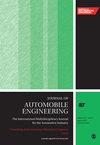The effect of an auxiliary spring on the decrease of contact resistance and contact temperature for power automotive connector
IF 1.5
4区 工程技术
Q3 ENGINEERING, MECHANICAL
Proceedings of the Institution of Mechanical Engineers Part D-Journal of Automobile Engineering
Pub Date : 2024-08-04
DOI:10.1177/09544070241266872
引用次数: 0
Abstract
Power automotive connectors used to connect two electrical systems in an electric vehicle should resist the rising of electric power or electric current. The latter can cause a rise in contact temperature by the Joule effect and can damage a connector improperly designed. The purpose of this work is to study experimentally and numerically the influence of the addition of a second spring on the ability of a power connector to transmit a high current. For this reason, an experimental test has been held on a connector without a second spring to measure contact resistance and contact temperature; then, a finite element model FEM of this connector was developed to compare and validate the numerical results with the experimental results. In addition, another FE model with a second spring was used to minimize contact resistance and contact temperature. Moreover, a theoretical model has shown its effectiveness in contact temperature and contact area calculations; it provides good agreement with experimental and numerical results. Numerical results show that the effect of the addition of a 2nd spring on the decrease of the contact temperature and contact resistance is significant. In addition, the thermo-electrical analysis by finite element shows that the current limit supported by a power connector with an auxiliary spring will equal twice the current supported by a power connector with one spring. FE mechanical analysis shows that the maximum mechanical stress in the connector with an auxiliary spring remains lower than the 2nd spring material yield stress. Finally, experimental and numerical results are in good agreement.辅助弹簧对降低汽车电源连接器接触电阻和接触温度的影响
用于连接电动汽车两个电气系统的汽车电源连接器应能抵抗电力或电流的上升。后者会因焦耳效应导致接触温度升高,并可能损坏设计不当的连接器。这项工作的目的是通过实验和数值计算研究添加第二个弹簧对电源连接器传输大电流能力的影响。为此,对一个不带第二弹簧的连接器进行了实验测试,测量接触电阻和接触温度;然后,开发了该连接器的有限元模型 FEM,将数值结果与实验结果进行比较和验证。此外,还使用了另一个带有第二弹簧的有限元模型,以最大限度地降低接触电阻和接触温度。此外,理论模型在接触温度和接触面积计算方面也显示出其有效性;它与实验结果和数值结果具有良好的一致性。数值结果表明,增加第二个弹簧对降低接触温度和接触电阻有显著效果。此外,通过有限元进行的热电分析表明,带有辅助弹簧的电源连接器所支持的极限电流是带有一个弹簧的电源连接器所支持电流的两倍。有限元机械分析表明,带有辅助弹簧的连接器的最大机械应力仍低于第二弹簧材料的屈服应力。最后,实验结果和数值结果非常吻合。
本文章由计算机程序翻译,如有差异,请以英文原文为准。
求助全文
约1分钟内获得全文
求助全文
来源期刊

CiteScore
4.40
自引率
17.60%
发文量
263
审稿时长
3.5 months
期刊介绍:
The Journal of Automobile Engineering is an established, high quality multi-disciplinary journal which publishes the very best peer-reviewed science and engineering in the field.
 求助内容:
求助内容: 应助结果提醒方式:
应助结果提醒方式:


